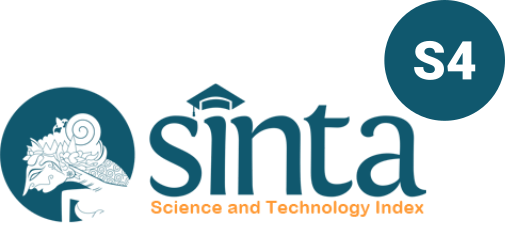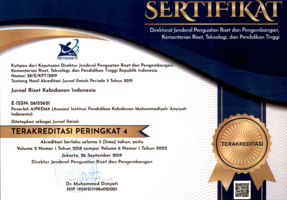Title:
Aspek biopsikososial ibu hamil bersalin dan nifas terkonfirmasi covid-19: Rapid review
Author:
Abstract
World Health Organization (WHO) menyebut coronavirus disease yang ditemukan pertama kali di Wuhan dengan novel coronavirus 2019 (2019-nCoV) yang disebabkan oleh virus Severe Acute Respiratory Syndrome Coronavirus-2 (SARS-CoV-2). Ibu hamil, bersalin, nifas dan bayi baru lahir juga merupakan sasaran yang rentan terhadap infeksi Covid-19 (Kemenkes RI, 2020).Tujuan dari Rapid Review ini adalah untuk mengetahui ibu hamil, bersalin dan nifas yang terkonfirmasi Covid-19.Dari 12 Artikel yang didapatkan ibu hamil, bersalin dan nifas terkonfirmasi Covid-19 dilihat dari aspek biologi, aspek psikologi dan aspek sosial. Tetapi masih diperlukan untuk mengivestigasi mendalam terkait pengalaman ibu hamil, bersalin dan nifas terkonfirmasi Covid-19.
Keywords
Full Text:
PDFReferences
Amalia, R., Hakimi, M. and Fitriani, H. (2020) ‘Evidence-based implementation of normal childbirth: what are the obstacles? (qualitative study)’, Journal of Health Technology Assessment in Midwifery, 3(2), pp. 115–126. doi: 10.31101/jhtam.1180.
Barresi, S., Bianchi, S. and Ciriello, E. (2020) ‘Vaginal delivery in SARS-CoV-2-infected pregnant women in Northern Italy : a retrospective analysis’, 24, pp. 1116–1121. doi: 10.1111/1471-0528.16278.
Bayrampour, H. et al. (2015) ‘Effect of depressive and anxiety symptoms during pregnancy on risk of obstetric interventions’, 41(7), pp. 1040–1048. doi: 10.1111/jog.12683.
Breslin, N. et al. (2020) ‘Coronavirus disease 2019 infection among asymptomatic and symptomatic pregnant women: two weeks of confirmed presentations to an affiliated pair of New York City hospitals’, The American Journal of Obstetrics & Gynecology MFM, 2(2), p. 100118. doi: 10.1016/j.ajogmf.2020.100118.
Brooks, S. K. et al. (2020) ‘Since January 2020 Elsevier has created a COVID-19 resource centre with free information in English and Mandarin on the novel coronavirus COVID- research that is available on the COVID-19 resource centre - including this for unrestricted research re-use a’, (January).
Brown, A. and Shenker, N. (2021) ‘Experiences of breastfeeding during COVID ‐ 19 : Lessons for future practical and emotional support’, (June 2020), pp. 1–15. doi: 10.1111/mcn.13088.
Cao, D., Yin, H., et al. (2020) ‘International Journal of Infectious Diseases Clinical analysis of ten pregnant women with COVID-19 in Wuhan , China : A retrospective study’, International Journal of Infectious Diseases, 95, pp. 294–300. doi: 10.1016/j.ijid.2020.04.047.
Cao, D., Chen, M., et al. (2020) ‘Vaginal delivery in women with COVID-19: Report of two cases’, BMC Pregnancy and Childbirth, 20(1), pp. 1–6. doi: 10.1186/s12884-020-03281-4.
Chen, H. et al. (2020) ‘Clinical characteristics and intrauterine vertical transmission potential of COVID-19 infection in nine pregnant women: a retrospective review of medical records’, The Lancet, 395(10226), pp. 809–815. doi: 10.1016/S0140-6736(20)30360-3.
Corbett, K. S. et al. (2020) ‘SARS-CoV-2 mRNA vaccine design enabled by prototype pathogen preparedness’, Nature, 586(October). doi: 10.1038/s41586-020-2622-0.
Dashraath, P. et al. (2020) ‘Coronavirus disease 2019 (COVID-19) pandemic and pregnancy’, American Journal of Obstetrics and Gynecology, 222(6), pp. 521–531. doi: 10.1016/j.ajog.2020.03.021.
Diamond, R. M., Brown, K. S. and Miranda, J. (2020a) ‘Impact of COVID ‑ 19 on the Perinatal Period Through a Biopsychosocial Systemic Framework Bio Psycho Social’, Contemporary Family Therapy, (0123456789). doi: 10.1007/s10591-020-09544-8.
Diamond, R. M., Brown, K. S. and Miranda, J. (2020b) ‘Impact of COVID ‑ 19 on the Perinatal Period Through a Biopsychosocial Systemic Framework Bio Psycho Social’, Contemporary Family Therapy, (0123456789). doi: 10.1007/s10591-020-09544-8.
Dotters-katz, S. K. and Hughes, B. L. (2020) ‘Considerations for Obstetric Care during the COVID-19 Pandemic’.
Dotters-Katz, S. K. and Hughes, B. L. (2020) ‘Considerations for Obstetric Care during the COVID-19 Pandemic’, American Journal of Perinatology, 37(8), pp. 773–779. doi: 10.1055/s-0040-1710051.
Freitas-Jesus, J. V., Rodrigues, L. and Surita, F. G. (2020) ‘The experience of women infected by the COVID-19 during pregnancy in Brazil: A qualitative study protocol’, Reproductive Health, 17(1), pp. 1–7. doi: 10.1186/s12978-020-00958-z.
González-timoneda, A. et al. (2020) ‘Experiences and attitudes of midwives during the birth of a pregnant woman with COVID-19 infection : A qualitative study’, Women and Birth, (xxxx). doi: 10.1016/j.wombi.2020.12.001.
Hcini, N. et al. (2021) ‘European Journal of Obstetrics & Gynecology and Reproductive Biology Maternal , fetal and neonatal outcomes of large series of SARS-CoV-2 positive pregnancies in peripartum period : A single-center prospective comparative study’, 257, pp. 11–18. doi: 10.1016/j.ejogrb.2020.11.068.
Karavadra, B. et al. (2020) ‘Women’s perceptions of COVID-19 and their healthcare experiences: A qualitative thematic analysis of a national survey of pregnant women in the United Kingdom’, BMC Pregnancy and Childbirth, 20(1), pp. 1–8. doi: 10.1186/s12884-020-03283-2.
Khan, S. et al. (2020) ‘Impact of COVID-19 infection on pregnancy outcomes and the risk of maternal-to-neonatal intrapartum transmission of COVID-19 during natural birth’, Infection Control and Hospital Epidemiology, 41(6), pp. 748–750. doi: 10.1017/ice.2020.84.
Langlois, J. et al. (2017) ‘Association of socioeconomic , school- related and family factors and physical activity and sedentary behaviour among adolescents : multilevel analysis of the PRALIMAP trial inclusion data’. doi: 10.1186/s12889-017-4070-9.
Lim, L. M. et al. (2020) ‘Special Report and pregnancy’, The American Journal of Obstetrics & Gynecology, 222(6), pp. 521–531. doi: 10.1016/j.ajog.2020.03.021.
Liu, D. et al. (2020) ‘Pregnancy and Perinatal Outcomes’, (July), pp. 127–132.
Liu, W. et al. (2020) ‘Clinical characteristics of 19 neonates born to mothers with’.
Mahajan, N. N. et al. (2020) ‘Preparedness , administrative challenges for establishing obstetric services , and experience of delivering over 400 women at a tertiary care COVID ‐ 19 hospital in India’, (September), pp. 188–196. doi: 10.1002/ijgo.13338.
Masjoudi, M. et al. (2020) ‘Explaining the experience of prenatal care and investigating the association between psychological factors with self-care in pregnant women during COVID-19 pandemic : a mixed method study protocol’, pp. 1–7.
Mcdonnell, S. et al. (2020) ‘European Journal of Obstetrics & Gynecology and Reproductive Biology The impact of the Covid-19 pandemic on maternity services : A review of maternal and neonatal outcomes before , during and after the pandemic’, 255, pp. 172–176. doi: 10.1016/j.ejogrb.2020.10.023.
Mizrak, B. and Nur, E. (2020) ‘The experiences of pregnant women during the COVID-19 pandemic in Turkey : A qualitative study’, Women and Birth, (December 2019). doi: 10.1016/j.wombi.2020.09.022.
Peng, S. et al. (2020) ‘The Lancet Regional Health - Western Pacific A study of breastfeeding practices , SARS-CoV-2 and its antibodies in the breast milk of mothers confirmed with COVID-19’, 4. doi: 10.1016/j.lanwpc.2020.100045.
POGI (2020) ‘No Title’.
Rasmussen, Sonja A et al. (2020) ‘Coronavirus Disease 2019 ( COVID-19 ) and’, (January).
Rasmussen, Sonja A. et al. (2020) ‘Coronavirus Disease 2019 (COVID-19) and pregnancy: what obstetricians need to know’, American Journal of Obstetrics and Gynecology, 222(5), pp. 415–426. doi: 10.1016/j.ajog.2020.02.017.
Ri, K. K. (2020) ‘Pedoman bagi ibu hamil, bersalin, nifas, dan bayi baru lahir’.
Sheng, W. H. (2020) ‘Coronavirus disease 2019 (covid-19)’, Journal of Internal Medicine of Taiwan, 31(2), pp. 61–66. doi: 10.6314/JIMT.202004_31(2).01.
‘Since January 2020 Elsevier has created a COVID-19 resource centre with free information in English and Mandarin on the novel coronavirus COVID- 19 . The COVID-19 resource centre is hosted on Elsevier Connect , the company ’ s public news and information ’ (2020), (January).
Slade, T., Johnston, A. and Browne, M. A. O. (2009) ‘2007 National Survey of Mental Health and Wellbeing : methods and key findings’.
Soma-pillay, P. et al. (2016) ‘Physiological changes in pregnancy’, 27(2), pp. 89–94. doi: 10.5830/CVJA-2016-021.
Thayer, Z. M. and Theresa E. Gildner (2020) ‘Birth plan alterations among American women in response to’, (April), pp. 969–971. doi: 10.1111/hex.13077.
Topalidou, A. and Thomson, G. (2020) ‘Covid-19 and maternal and infant health : Are we getting the balance right ? A rapid scoping review’, pp. 1–16.
‘Universal testing for severe acute respiratory syndrome’ (2020), (January).
Wu, Y. (2020) ‘Coronavirus disease 2019 among pregnant Chinese women : case series data on the safety of vaginal birth and breastfeeding’, pp. 1109–1115. doi: 10.1111/1471-0528.16276.
Zhao, Y. et al. (2020) ‘Evaluation and design of public health information management system for primary health care units based on medical and health information’, Journal of Infection and Public Health, 13(4), pp. 491–496. doi: 10.1016/j.jiph.2019.11.004.
Zhu, N. et al. (2020) ‘A Novel Coronavirus from Patients with Pneumonia in China, 2019’, New England Journal of Medicine, 382(8), pp. 727–733. doi: 10.1056/nejmoa2001017.
DOI: https://doi.org/10.32536/jrki.v5i1.163
Article Metrics
Abstract view : 4674 timesPDF - 1166 times
Cited By
Refbacks
- There are currently no refbacks.
Copyright (c) 2021 Jurnal Riset Kebidanan Indonesia

This work is licensed under a Creative Commons Attribution-ShareAlike 4.0 International License.
Jurnal Riset Kebidanan Indonesia
Indexing by:
Diterbitkan oleh:
AIPKEMA (Asosiasi Institusi Pendidikan Kebidanan Muhammadiyah-'Aisyiyah Indonesia)
Universitas ‘Aisyiyah Yogyakarta, Jl. Siliwangi (Ring Road Barat) No. 63, Nogotirto, Gamping, Sleman, Yogyakarta 55292.
Telp. (0274) 4469199; CP: 081236093816; Email: aipkemajrki@gmail.com; dewik.2011@gmail.com

This work (Jurnal Riset Kebidanan Indonesia) is licensed under a Creative Commons Attribution-ShareAlike 4.0 International License.










 Abstract views : 4674
|
Abstract views : 4674
| PDF views : 1166
PDF views : 1166


